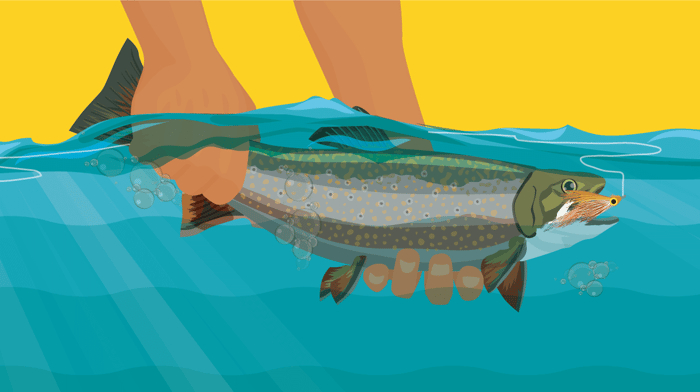Gear selection:
-
Use tackle that is appropriate for the size and type of fish (light gear can result in a fish dying of exhaustion or stress soon after its release).
-
Use circle hooks to increase a fish’s chance of living once it is released.
-
Stay with your gear to ensure that fish are retrieved as soon as they are caught (minimises stress and potential injury).
Removing hooks:
Whenever possible try to remove the hook while the fish is still in the water (try not to remove the fish from the water).
-
If the fish is hooked in the jaw or mouth, remove the hook using a hook remover or long-nosed pliers.
-
If the fish is hooked deep in the stomach leave it there and cut the line as close as possible to the mouth.
Unwanted fish:
When you catch a fish:
-
out of season
-
outside of legal limits (size, bag, possession)
-
that you do not wish to keep (e.g. toadfish, rays, native seastars, nontarget species) release it immediately and with the least amount of damage or injury (i.e. the least amount of handling).
Handling fish:
A fish’s body has a slimy protective coating, which can be damaged by excessive handling. Incorrect handling damages fish and reduces their chances of survival after release. Fish can also suffocate (lack of oxygen) and suffer internal soft tissue injury (organs are crushed) when lifted incorrectly or inappropriately handled.
If you must handle a fish (to check its identity or size) reduce damage by:
-
using a dip/landing net without knotted mesh
-
using wet hands or a wet towel to handle it
-
placing the fish on cool and wet surfaces (not on hot and dry surfaces).
Releasing fish:
When releasing fish, hold the fish horizontally and gently under the water, if possible. Wait until it revives then release your hold so it can swim away.
Do not release noxious fish species – this is illegal. You must kill noxious species, such as carp. To dispose of carp, cut up the carcass and put into the water, or take the carcass away with you.
Dispatch fish:
It is good practice to immediately kill the fish you intend to keep.
-
Dispatch them with a quick blow to the head.
-
Place dead fish in an ice slurry and store them away from sunlight (preferably in a moist bag or cooler).
Cleaning your fish:
Some species must not be filleted while you are fishing. This is to ensure that size and catch limits for key species are adhered to. Before you clean your fish remember to check if the species you have caught is to be kept in carcass form or not.
Disposing of old fishing line and fish waste:
Dispose of old fishing line in bins. If no bins are provided, take it home, cut it up and dispose of it in general domestic waste.
Put fish waste (carcasses, frames, guts, etc.) in bins. If no bins are provided, take it home and dispose of it in general domestic waste. Don’t throw fish waste into the water on beaches or near cleaning tables because it can attract sharks and rays. Do your bit - please leave your fishing spot cleaner than you found it.
Credit: Fisheries Victoria


